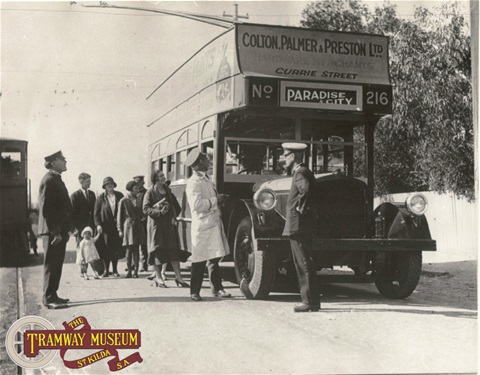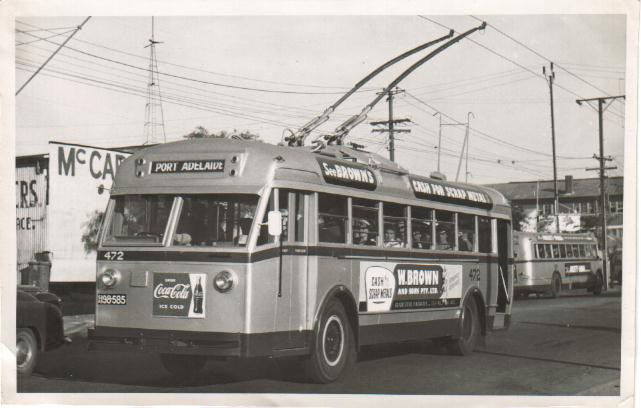The Payneham to Paradise Trolley Bus
In 1932 the world was in the midst of the Great Depression. In Australia the unemployment rate peaked at 32%. Men, who ,in just over a decade and a half before that time, were caught up in the horrors of Gallipoli, and the Western Front, were again confronted with trauma, this time at home. Cast out of their employment, through no fault of their own, unable to feed themselves and their families. This was the background of the Municipal Tramways Trust, (MTT) when they realised they had to expand the public transport system in Adelaide.1 The preferred system of public transport, in that era, was the electric tram. An extensive tram network already existed in the suburbs. With the Great Depression still in place money was tight. Tram networks were expensive to build, requiring substantial work to install tracks in suburban streets. With this in mind the MTT decided to experiment with electric Trolleybuses, in place of electric trams.
Trolleybuses were in use in other parts of the world, but not in Australia. The experiment was to be conducted on the existing tram line between Payneham and Paradise. In this way Adelaide became the first place to use trolleybuses, in the whole of Australia. During peak periods the tram would still run from the city to Paradise. In off peak periods the tram would terminate at Payneham, and the passengers would transfer to a trolleybus to continue on to Paradise. This also happened on the return journey, and only in off peak hours. The existing overhead electrical tram power lines were used to supply electric power to the trolleybus.

The “Green Goddess”, No 216
The above photograph is of the first trolleybus in Australia on the first day of trials in March 1932
Photo Courtesy of the Adelaide Tramways Museum St. Kilda
The MTT decided to build a trolleybus for the experimental trial. This was carried out at the Islington railway works. An open top, double deck, Garfield, petrol bus was converted. The petrol engine was removed and an electric motor fitted. The upper deck was cleared of all seating and the poles that picked up the electricity were attached there. The rear platform and stairs were also removed. With the removal of the upper deck seats, the seating capacity was reduced to 23, with room for a further 20 standing. It was painted in green and cream livery and became known as the “Green Goddess”. The “Green Goddess” No 216 is preserved at the Adelaide Tramway Museum at St. Kilda.
On March 1st 1932 the experimental service began on the Payneham to Paradise section. 2 As previously stated the trolleybus only operated during off peak hours. The trial ceased in August 1934 and was hailed as a success.
The MTT decided to use trolleybuses on other routes, and in 1938 a regular service started from Light Square in the city, to Tusmore in the eastern suburbs. This was soon followed by a service, also from Light Square, to Port Adelaide, Semaphore and Largs. Other lines converted to trolleybuses were the Erindale line and the Linden Park line.
Just prior to the Second World War, a shipment of British Leyland chassis, bound for China, was sold to the MTT and these were fitted out as trolleybuses at the Islington railway works. The conversion took place between 1942 and 1945. They were known as Canton’s or Wombats. One of these is also preserved at the Adelaide Tramway Museum at St. Kilda.3

The above Photo shows one of the Canton Trolleybuses by Doug Colquhoun from Wikimedia Commons.
The Canton trolleybuses had a crush load of 60 persons and remained in service until July 1963, when they and all other trolleybuses were replaced by petrol engine buses. 4
This article has been researched and compiled by Jim Nelson, a volunteer with the Campbelltown Library Digital Diggers group.
If you have any comments or questions regarding the information in this local history article, please contact the Local History officer on 8366 9357 or hthiselton@campbelltown.sa.gov.au
References
- Wheaton, RT (1975). Destination: Paradise. Sydney: Australian Electric Traction Association. pp. 42–50. ISBN 0 949825 01 8
- The Adelaide tramways, pocket guide. A catalogue of rolling stock 1909–1974. Adelaide: Municipal Tramways Trust. 1974. p. 8.
- Trolleybuses Tramway Museum Adelaide
- Steele, Christopher (2014). Trolleys west. Elizabeth: Railmac Publications. p. 3. ISBN 9781864770988.
